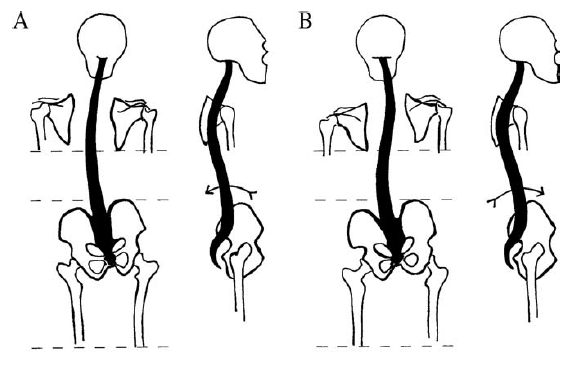Sacroiliac Joint Pain
Pelvic Malalignment
The chart below is from Timgren et al, and outlines the changes seen on examination with pelvic malalignment.[1]
| Innominate | A. Posterior rotation | B. Anterior Rotation |
|---|---|---|
| Iliac Crest | Elevated ↑ | Elevated ↑ |
| ASIS | Elevated ↑ | Depressed ↓ |
| PSIS | Depressed ↓ | Elevated ↑ |
| scapula | Depressed ↓ | Elevated ↑ |
| leg | Longer ↑ | Shorter ↓ |
| 10-15mm lift | Increased crest difference ↑ | Reduced crest difference ↓ |
| Spinal curvature | C type scoliosis | S type scoliosis |
| C0-C1 function | Symmetric rotation in flexion | Restricted rotation in flexion |
All changes are in reference the ipsilateral side.
Rising of the crest upon anterior SI rotation is paradoxical, and its explanation cannot be reduced to a two-dimensional model.
Schamberger’s (2013) rule of the five Ls, which relates to the side of the anteriorly rotated innominate: “Leg Lengthens Lying, Landmarks Lower” (supine vs long sitting) [2]
Those patients showing pelvic asymmetry caused by dysfunction of the SI joint received one of two treatment options: (1) high-velocity and low-amplitude thrust technique applied through the ankle on the side of the dysfunctional SI joint or (2) restoration of symmetry by the selfembracing muscle energy technique. In this procedure, a patient resists thigh extension, alternating on both sides, to produce a corrective rotational force on the pelvis. Both methods have been described in detail elsewhere.3,12 The estimation of asymmetry as described was repeated after the corrective treatment.


